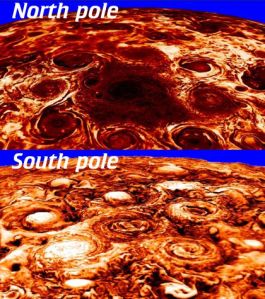“Sorry, Vinnie, if there’s anything to your ‘Big Skip‘ idea you can’t blame Jupiter’s Great Red Spot on Io.”
“Come again, Cathleen? Both you and Sy were acting intrigued.”
“That was before I looked up a few numbers. You suggested that a long‑ago grazing collision between Io and Jupiter could account for Jupiter’s weird off‑center magnetic field, its Great Red Spot and Io’s heat and paltry waterless atmosphere. The problem is, there’s two big pieces of evidence against you. The first is Io’s orbit. It’s almost a perfect circle, eccentricity 0.0041, less than half the average of the other Galilean moons. A true circle has zero eccentricity compared to a parabola at 1.0.”
“So why is that evidence against the idea?”
“There’s virtually zero probability that a chaotic skip would send Io directly into such a perfect orbit. Okay, repetitive tugs from Ganymede’s and Europa’s gravity fields could conceivably have acted together to circularize and synchronize Io’s behavior but that would take millions of years.”
“So it’d take a while. Who’s in a hurry?”
“Your idea is, because of the second piece of evidence. Jupiter is a fluid planet, gaseous‑fluid much of the way in, liquid‑fluid most of the rest, right? Lots of up‑and‑down circulation due to outward heat flow from Jupiter’s core, plus twisty Coriolis winds at all levels powered by the planet’s rotation. All that commotion would smear out any trace of your grazing collision, probably within a hundred thousand years. The scars from Shoemaker-Levy’s impact on Jupiter were gone within months. Circularization’s too slow, smearing’s too fast, idea’s pfft.”
“Oh well, another beautiful picture bites the dust.” Vinnie glances up and to the left, the thing he does when he’s visualizing stuff. (On him, a quick glance up and to the right is a bluff tell but he knows I know which makes things interesting.) “Okay, so we’re thinking about how Jupiter’s weird atmosphere and how its equator rotates faster than its poles. That cylinder spinning inside a spinning cylinder idea looks nice for an explanation but I can think of a different way it could happen. How about like a roller bearing?”

“Hmm?”
“Big spinning columns deep inside all around the planet. Think about what goes on in between those cylinders you talked about — two layers flowing at different speeds right next to each other. There’s gonna be all kinds of watchacallit – turbulence – in there, trying to match things up but it can’t. Sooner or later twisters are gonna grow up to be north‑south columns.”
“He’s got a point, Cathleen. His columns would reduce between‑layer friction at the cost of increased between‑column friction. Depending on conditions that could give a lower‑energy, more stable configuration.”
“Spoken like a true physicist, Sy. Columns may be part of the story, but not all of it. There’s mostly‑for evidence but also really‑against evidence.”

“Give us the ‘mostly‑for,’ make us feel good.”
“You guys.” <drawing tablet from her purse, tapping screen> “Alright, here’s a couple of images that Juno sent us when it orbited over Jupiter’s poles.”
“Sure looks like what was in my mind. I’ve seen that before somewhere…. Yeah, Al had that poster up behind his cash register like five years ago.”
“Impressive memory, Vinnie. Anyway, those vortices are similar to your idea, except look at these images critically.”
“Wait, different whirlpool counts top and bottom.”
“Right. These columns obviously don’t go all the way through. They must extend only partway inward until they’re blocked at some lower level.”
“Why can’t I have my columns all the way through if they’re outside the blocking level?”
“You could and there may be something like that inside the Sun, but that’s probably not the case for Jupiter.”
“Why not?”
“That’s the ‘really‑against’ evidence — the Great Red Spot and Jupiter’s off‑center magnetism. Something’s powerful enough to cause those two massive phenomena. That something would disrupt your ring‑in‑a‑ring rotation, at least down to the level where the disrupter lives. Your columns could only operate in some layer deeper than the disrupter’s level but above whatever’s blocking the polar columns. If there is such a layer.”
“Geez. Well, a guy can still hope.”
“But that’s not Science.”
~~ Rich Olcott

